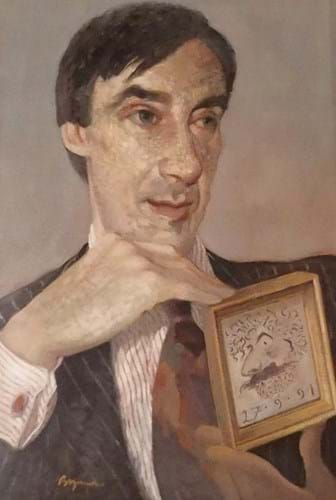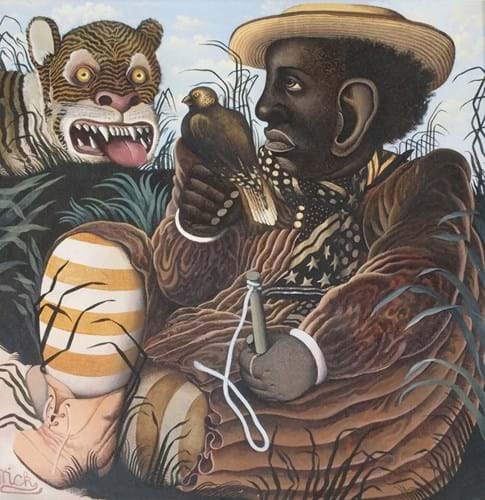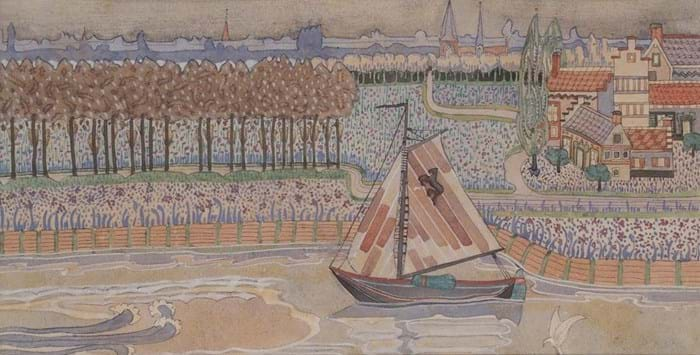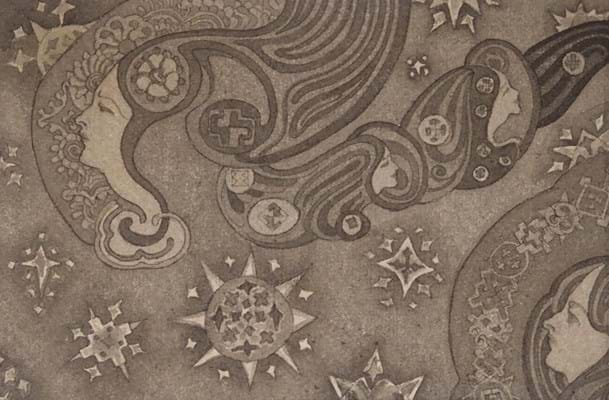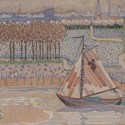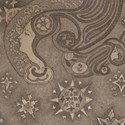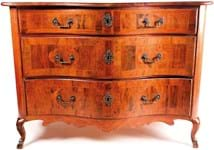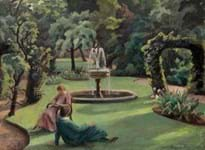
The recent run of well-known dealers’ collections selling at the rostrum migrated north of the border with the William Hardie sale at Great Western Auctions (24% buyer’s premium) of Glasgow
‘Bill’ Hardie (1941-2021), who died in January, was a major figure in the Scottish art scene for over five decades as an art historian, museum director, auctioneer and dealer – crossing over the curatorial and commercial spheres.
The dedicated auction of 291 lots from his estate, mostly pictures but also some furniture, ceramics and books, at GWA on August 28 followed a spate of dealer collections being sold, including the Cyril Fry collection at Sotheby’s and Chiswick Auctions (see ATG No 2506) and the Oliver Hoare print collection at Dominic Winter (ATG No 2507).
Meeting an equally good reaction, the sale was a white-glove affair with the hammer total just over £190,000.
The consignment of Hardie’s private collection and contents of his home was secured by GWA’s senior auctioneer Paul Howard who knew Hardie well, having worked with him first at Christie’s in the early 1980s and then later in his gallery in the early 1990s.
Growing up in the west of Scotland, Hardie became a fine art researcher at Glasgow University and was later appointed a curator at the McManus art gallery and museum in Dundee. Crossing over to the auction world, he joined Christie’s in 1977, becoming a director and setting up the Scottish picture department which he ran until 1984, helping put groups such as the Scottish Colourists and the Glasgow Boys firmly on the map.
Leaving to set up William Hardie Fine Art in Glasgow, his gallery in West Regent Street became renowned for its discoveries and ground-breaking exhibitions. Having mounted show after show until the lease on the building ran out in 2000, he relocated in West Nile Street until finally closing the gallery in 2008.
Hardie continued to research and write following his retirement.
How he secured one of his greatest triumphs – bringing David Hockney to Glasgow for the first and only time in 1993 – was recalled in a foreword in the GWA catalogue by the film-maker Murray Grigor. She wrote: “He won over Hockney with several trips to his studio. Perhaps the clincher was experiencing the artist’s ‘Wagner Drive’ from Malibu, drifting around the many bends of Mulholland Drive in a thunderstorm over the Hollywood Hills, with Hockney driving while balancing his dachshund on his lap with Parsifal playing full blast to the beat of the windscreen wipers in the rain.”
The show organised by Hardie featured 22 of Hockney’s latest paintings. It was widely acclaimed and brought over 10,000 people, including the artist, to his gallery – visitor numbers that exceeded any show even at public galleries in Scotland at the time. “We’ve had great shows in the past but never as exciting as this,” Hardie told the Glasgow Herald. “It’s a show I’ve dreamt of having for years… it’s a heavyweight show but the paintings are lyrical, joyful, and fun.’’
Hardie by Hockney
It was appropriate that the top lot in the GWA should be a portrait of Hardie by David Hockney (b.1937) himself. The 2ft 5in x 22in (76 x 57cm) graphite crayon drawing dated from a year after the Glasgow exhibition. It also featured in Hockney’s monograph released that year titled New Drawings, Some Drawings of Family, Friends, and Best Friends.
In terms of its condition, the drawing was originally float mounted within the frame using tape at the each of the four corners. This had since has become unstuck and some small blemishes were visible on close inspection as were two very small loose fabric fragments located to the lower area.
But in an overall decent state, the appealing subject as well as quality of execution meant it was always likely to sell well beyond its £3000-5000 estimate. With eight phone lines booked, it sold to a London gallery at £33,000 – topping the sale by a considerable margin.
The same buyer secured another portrait of Hardie by Scottish artist John Byrne (b.1940), a name also closely associated with the Hardie gallery and for whom the dealer staged successful exhibitions. Overshooting a £4000-6000 pitch, it was knocked down at £8000 after underbidding from Scottish private and trade buyers.
The 2ft 2in x 17¾in (65 x 45cm) oil on canvas was painted to mark the 50th birthday of the sitter in 1991. It was commissioned by Hardie’s wife Gillie and appears on the front cover of his 2017 book Gallery: A Life in Art which recorded Hardie’s 50 years in the art world. In reference to this painting, Hardie wrote it was “the closest I have come to being psychoanalysed”.
The sale featured five works by Byrne, all of which sold for a combined £28,000. The highest price came for The Pink Boot, a 18½ x 18in (47 x 46cm) pen, ink and gouache signed Patrick – the name sometimes used by the artist and playwright (he first signed his father’s name on his pictures after being rejected by London galleries, while Gerry Rafferty later wrote a song called Patrick about the artist).
While the artist’s numerous self-portraits tend to command the most money, his manic and somewhat surreal subjects also represent a substantial part of the artist’s oeuvre. This picture, which had a William Hardie Gallery label on the back, drew lively interest against a £4000- 6000 estimate. It was knocked down at £11,000 to a Scottish gallery which saw off bidding from a number of private Scottish buyers.
Early death
Two of the lots drawing the most competition at the sale, however, were earlier pictures by George Dutch Davidson (1879-1901), an artist whose early death means works are incredibly scarce.
Yorkshire-born Davidson moved to Dundee with his family in his youth and turned to art after having to abandon hopes of a career in engineering because of contracting influenza. Working in a studio alongside Celtic Revivalist painter John Duncan (1866-1945), he produced illustrations for Patrick Geddes’ The Evergreen magazine but also executed some striking Symbolist paintings.
Few have emerged at auction, although a large decorative panel with three female figures did make £6670 (including premium) at Christie’s back in October 1999.
These two works from the Hardie collection were small watercolours and, with little precedent on which to base estimates, were offered at much lower levels. First up was a 5 x 8in (13 x 20cm) watercolour titled Female Head Design, an eyecatching work with women’s heads floating among evocative Symbolist patterns.
Estimated at £300-500, it sold for £7500. An auction record, it stood for just under half an hour when it was topped by Boats on a River, a colourful 5 x 9¾in (13 x 25cm) watercolour which was the kind of picture that followers believe looks forward to later Art Deco styles. In good condition other than some light foxing, it overshot a £500-700 estimate and sold at £8000 to a Scottish private buyer who saw off bidding from the Scottish trade.
The prices for these small works on paper makes you wonder what his larger works would make if only they could be sourced. Whether or not they could reach the five-figure and even six-figure sums achieved on occasion by his companion John Duncan, their performance at auction here seemed again to underline Hardie’s keen eye for talent.


